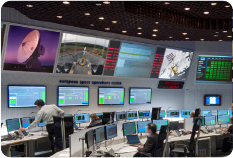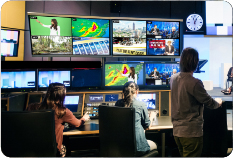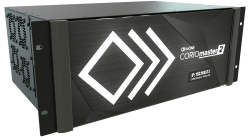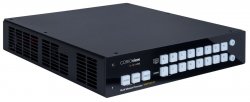
© KHON in Hawaii
Optimize your rack space for easy servicing and cable management
At first glance, technical setups in TV and broadcast installations appear to revolve around “big ticket” gear which will normally mount in standard 19” racks, but there is also a host of other smaller devices in the mix including signage players, signal extension, and distribution amplifiers. When discussing the challenges of integrating these small, DC powered devices to either the system integrator or the in-house broadcast engineer, they will tell you about the considerable time, effort, and money they spend to install and service them. They will also mention how finding a space-saving, clean, and efficient solution for this range of equipment would solve so many headaches.
In this blog, we will explore just how easy it is to effectively integrate small, DC powered devices into your broadcast installations, including those that are critical to the viewer experience. Many of the efficiencies we will explore could equally be enjoyed in outside broadcast setups as well.
Easy designs
The holy grail of rack design is to be able to go onsite with an exact picture/drawing of what kit goes where and to use this picture/drawing as a precise “as built” resource for later fault finding. However, anyone who has ever seen the back of a typical rack will testify that this is rarely the case for small items of gear. When it comes to designing a rack layout, the large items are simple to plan as they are invariably built to 19” form factors; however, when you go to half rack items and smaller, you are faced with some challenges as the rack design phase can become tricky to create accurate layouts or cost estimates at the quoting stage.
Using ONErack removes the headaches and allows your tech to mount small devices to the mounting module rather than having to be a contortionist in the back of rack! They will not only be happier, but far more efficient, saving you time and money!
Maximizing your rack space
Velcroing or cabling tying are the traditional methods to racking and attaching all your small devices to a rack shelf. This will appear to be a cost-effective solution until you are trying to trace faults, service them, or keep your kit cool to extend the life of the units within a full rack. A popular option to bring order to a rack is to use a 1RU shelf which can be a good option for halfwidth 1RU devices, however this solution rarely gives high enough density, as many small devices are less than 1RU tall without considering the cable runs for power, network, and
signal cables.
Using tvONE’s ONErack, you can take advantage of huge efficiencies with up to 32 devices within a single rack, not to mention easier cable management and the removal of wall warts from the rack.
Stay cool: extending equipment life
Large rack mounted items such as PC’s, media servers, and matrix switchers will undoubtedly have thermal management design at the forefront to avoid over heating, but what about the multitude of small devices peppered around your rack? They can often be bathed in the hot air exhaust from the large ticket items. This will vastly reduce their lifespan or cause intermittent failures as it is a fact that every 8ºC (18ºF) above 21ºC (70ºF) reduces long term reliability by 50%. There are several rack cooling options out there including front, rear, and top exhaust options but what is missing from these is localized cooling of small items. A failure here will likely cause wider system issues. With ONErack, you can tailor the airflow to push or pull the hot air from your rack. Additionally, it can run at different speeds and at a maximum, can clear up to 228 Cubic Feet per Minute or up to 4850 BTU which is more than enough to cater with any set up.
Go beyond single voltage options
Ask any experienced broadcast engineer what gives them headaches and DC power problems will always figure in the top three! While, many other pain points have been addressed with technological innovation, DC power has remained static in terms of evolution with the humble wall wart and single or dual voltage rack mount power units being your only options until now.
Not all rack mount DC power supplies are born equal, so it is worth asking questions about total power output and the number of voltages you can access. Even some larger power units can have limited outputs, and while adding another unit is an option, this adds to project cost and uses expensive rack space. Also, check which voltages you can output. While many “AV only” installs only require 5 or 12 volts, a divergence in the marketplace between AV, IT, and Broadcast solutions has seen a demand for other voltages including 7.5, 13.5, 18, and 24 volts. Using an “AV only” power supply will only add to your issues.
Learn more
If your next Broadcast, AV, or IT installation demands mission-critical performance, multi-voltage power and cooling, then check out tvONE’s ONErack. Additionally, for smaller, flexible mounting options, check out tvONE’s newest DC power offering, the ONErack Spider.
Download the full version of this blog in order to learn about the solutions tvONE can offer:

















